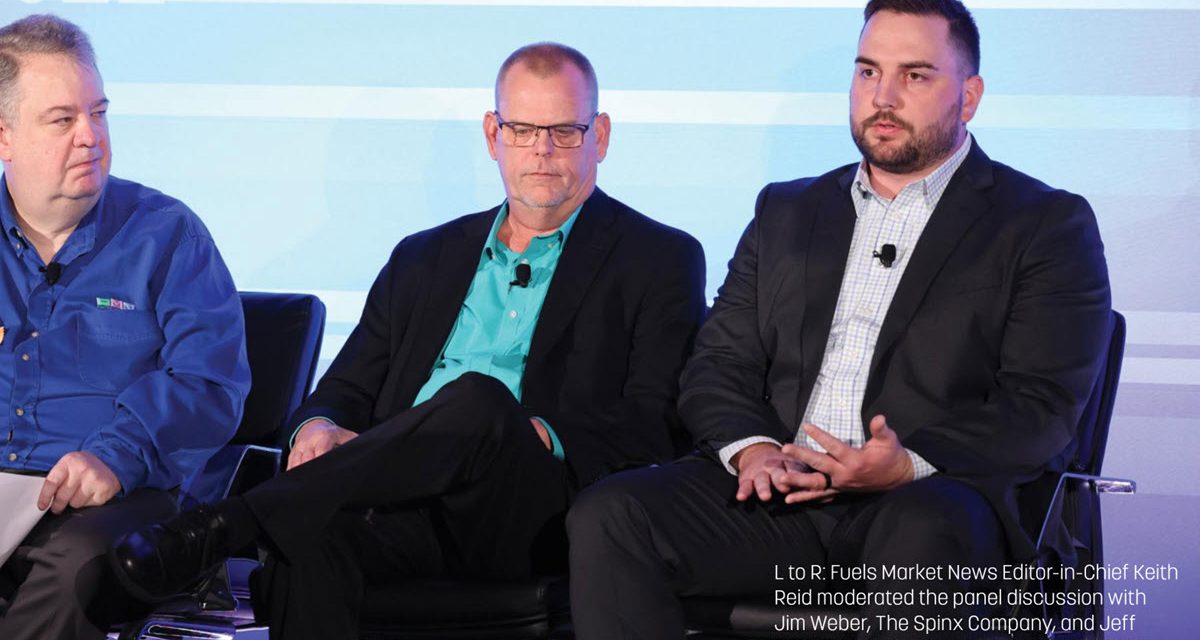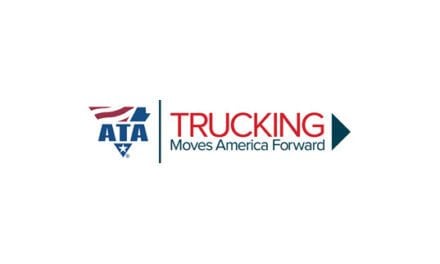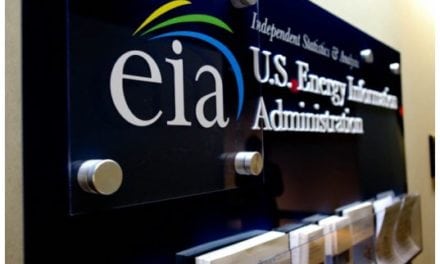Kwik Trip and Spinx leaders discuss fuels and charging and include some of their best practices.
By Keith Reid
Fuels Market News Magazine awarded the 2022 FMN Fuels Innovator of the Year Award on October 3, 2022, at the NACS Show, held in Las Vegas. A lively discussion followed the formal award presentation with Jeff Reichling, Kwik Trip Inc.’s general manager of fuel operations, and Jim Weber, The Spinx Company’s executive vice president of merchandise and marketing. Here are some of the highlights.
FMN: How do your companies view fueling/charging on the forecourt compared to the rest of your operations “inside the box”?
Reichling: At Kwik Trip we understand that conventional fuels—alternatives as well—play a large part in the marketplace. We try to stay ahead of what is coming next or what our guests are going to want down the line. I think we’ve done a great job inside the box for a lot of years being innovative. We’re trying to match that same intensity on the outside.
Weber: Fuel is very prominent for us at Spinx. It starts with the forecourt—keeping it maintained, well cleaned, up to date with technology. It’s our biggest category. We fuel 22 million people a year. So, to me it is category management on the retail side and day-to-day blocking. That customer experience when you get on the lot—clean, neat, your equipment working—that’s big.
We have a good system where our maintenance and facilities tie into our operations group. So, the real time maintenance and upkeep of our forecourt is paramount daily. I think the other big thing is just having a separate retail pricing unit as its own group that allows focus on the competition and making sure we’re well priced. And the third component for us is the way we tie it into loyalty. That is a big thrust and has been for many years, so you get the additional savings and efficiency for the customer.
FMN: Both of your companies were out in front of expanded fuel offering for years—well ahead of current pressures. What drove that?
Weber: For me that answer is easy—Stewart Spinks. Stewart has been the quintessential innovator for years, almost to the point where you must bring him back in sometimes. Stewart loves to dabble in new things, and when I say dabble, he likes to get in there, invest in it to a small degree to where he won’t break his leg but might skin his knee. Ethanol has been a great example. We may start at a small scale and watch it for years. We believe that with the innovation, having real numbers to watch in your own P&L and understanding [the process] of the innovation has a high value.
Reichling: It’s along the same lines at Kwik Trip. Our owner Don Zietlow and his family have been extremely supportive and aggressive on growth for a lot of years. I think our biggest challenge is not getting approval or funding to take on these new initiatives, but rather how we’re going to meet the timeline and expectations that Don sets. And that’s a good problem to have in a growing company.
FMN: What role does technology play in both facilitating the fuel logistics and retail?
Reichling: Like everybody else, we’re trying to keep pace with what technology offers and what’s valuable to our company. From a logistics standpoint, it certainly offers us a lot of opportunity with our internal fleet to analyze data, understand where we can be more efficient and what makes sense logistically in our regional footprint. For example, instant communication with drivers—not picking up the phone at the rack if we do have some sort of a problem but messaging and things like that—so we can be more efficient and utilize time better from a dispatch perspective. There’s a host of software out there on the logistics side that make it easier to view and a better process in general—not so manual—that ties into the supply side and the procurement to make sure that we understand where we’re going and what we’re trying to accomplish on a given day.
With the storefront it’s the same idea but a different concept. There’s a lot of software out there that helps us understand consumer behavior and what our competition’s offering and what we need to do to be competitive in the marketplace. I think in general that analytics and the information systems that go with that are vital to the success and the growth of our company.
Weber: We’re not dissimilar, just on a smaller scale. The thing that Jeff said that that resonates the most with me is keeping pace with technology. It’s constantly evolving at the pump, and loyalty as well for us. Budgeting really comes into play there, and probably the best advice I can give is getting ahead of that with planned obsolescence, especially out on the forecourt. You must have a regimented plan to apply capital, or else you’re going to wind up behind the curve. I think that’s helped more than anything.
And then the ancillary stuff—how do you tie in your loyalty programs and get the pump interface going with mobile apps. I think that’s challenging for a lot of companies even that are ahead of the curve, and I don’t see that going away anytime soon. So, we look at that and we’ve done a good job with the hardware. We’ve been done a good job with our NTI (new to industry) sites and putting the most current technology in there. Our next challenge is how do we keep that loyalty momentum going and keep that relevant to the customer?
FMN: How do you attract and keep drivers in your fuel logistics operations?
Reichling: It’s not an easy business, and it’s only gotten more difficult, obviously, in the last three to four years. You try to be as competitive as you can with pay and benefits and good equipment, safe operation and good training. Getting the driver home every night certainly doesn’t hurt. And you offer them an opportunity to be successful in what it is they’re doing. But, for us it’s much larger than that. Kwik Trip has always believed strongly in our mission statement of treating others like we want to be treated. It’s at a very basic level.
As with all of our workers it’s constant communication, constant contact with the leadership team and letting them know where Kwik Trip is headed in the future. We make it known that they’re a stakeholder in the business and, and they have a say in where we’re going in the future—they’re going to drive that.
Weber: Obviously, being competitive with pay is first and foremost. We’re a smaller transport company, but we face the same challenges Jeff noted. Our leaders focus on the quality of life for those drivers. Getting them home every day with great equipment and short shifts so you’re not keeping them out on the road. Our wholesale division took the time to set up different markets with our trucks eliminating some long hauls. I think we’re just fighting the fight that everybody else is, and it starts with paid benefits, good hours and, to Jeff’s point, being treated like a part of the family.
FMN: EV charging is a huge buzz in the industry, but as we’ve been reminded in some of the sessions at the Show even in the most aggressive net-zero carbon future we’re likely looking at decades before serious penetration occurs. How are you approaching EV charging in your operations?
Reichling: To us, like any alternative option, we want to understand it. We want to understand what role Kwik Trip might be able to play in that future. I think, candidly, that’s a little bit unclear right now. We’ve rolled out a handful of locations that have some charging capabilities. There’s a possibility that it’s going to be a little bit later adoption in the upper Midwest than some of the other areas of the United States. If that’s not the case we’re ready to have that offering for our consumers.
Charging locations may differ from conventional fuels—I think the industry recognizes that as well. There’s going to be different options, whether it’s at home or place of business, and that’s definitely a different approach than what we’ve seen with conventional fuels. So, we certainly want to understand it and continue down that path. But we also feel that conventional fuels are going to be a large part of our business for a long time to come. And it will continue to be a multifaceted approach between all the alternatives we talk about where we find success with into the future.
I would add it doesn’t necessarily change growth plans, but it certainly adjusts how you view sites going into the future. Do you have space for electric charging and the needs that might have as compared to your traditional offerings? Historically, I think we all try to be as efficient as we can in store layout and store setup. And real estate is expensive, but that’s certainly an additional space that you didn’t account for in some of our locations, and I think others in the industry are probably in the same boat. And the other piece is, quite simply, is the [electrical] service to the store sufficient for what you need for that type of operation? That is something that might need to be upgraded as you get on the EV path.
Weber: We’re cautious about it, but we’re in the game. We started off around 2011 with our first sets of EV stations—level one chargers at three stores. Once we got past people trying to use them as air pumps [laughter], we opened our game to doing level two chargers at seven sites that were strategically placed across South Carolina. The premise being that our South Carolina residents could charge anywhere on their journey across states. So, we’ve had that in place for several years, and some sites got a little traction depending on the corridor we put them in.
We’re [running conduit] for EVs with new sites. When people are looking at electrifying the country and they’ve got all these hard targets of 2035 or such, we don’t listen to any of that. I think the auto manufacturers need to step up and start talking about hybrids and the things that are going to help fill that gap for carbon neutrality. EVs have a lot of challenges ahead. We don’t toss it to the side—we embrace it—but I don’t think it’s the only answer.
With our latest venture we partnered with Tesla, and we opened a Tesla supercharger site at one of our locations in Orangeburg, South Carolina. It’s at the crossroads of I-26 that bisects South Carolina and the I-95 corridor, so obviously a hot zone for traffic. Involving ourselves in that partnership allows us to see real-time data, so you can study that and understand whether it’s going to be a profitable venture or not.
One of the other things that we’re doing right now, and it’s behind schedule, is South Carolina’s a very hot place and especially out on the highway. We partnered with Tesla and invested with them to install a canopy over the EV chargers because no one wants to sit in their car for 20-25 minutes and get baked like a potato. This is a solar canopy that provides a little green initiative by pumping energy back into the system.
Universal plugins also need to be found. There’s just a lot of stuff there. That’s why I like coming [to the NACS Show] and hearing some of the same opinions that we have because it gives you a little bit of confidence to know that other people are going through this. I would say keep an open mind and talk to the equipment manufacturers.
FMN: When you are offering five or six grades of gasoline and five or six grades of diesel, how do you educate the customers on what you are offering and how will they benefit?
Reichling: I think for us, consistency among stores is key. We try to have the same product offerings among different stores. But as far as education, especially with a product like an E15, you do what you can. We did signage on the pumps to explain what it is as quickly as we rolled that out. You do pamphlets, you do education within stores and there’s always our support center number. But candidly, it just takes time. I would argue there’s probably still some consumers that don’t fully understand the differences with all the various grades that we offer, but you just try to be as proactive as you can upfront and then as responsive as you can be after the fact to make sure that they’re getting the answers they’re looking for.
Weber: If you have some versatility in your main IDs—your road signs—we do a little bit of that. We’re not as deep into the ethanol scene as Jeff is, but one of my bigger challenges right now is just getting street signs up to date and getting a uniform look out there on that. And I think once you make the price obvious to the customer that lends a hand in describing the fuel as well.
FMN: Jeff, could you describe how you set up your CNG corridor and what you see as the role of CNG today?
Reichling: We’ve been in the natural gas business since about 2012. It started out with the idea that because we have our own fleets (perishable and fuels) 365 days a year, we were a good anchor customer for that type of business. So, we looked at that as an opportunity to learn more about natural gas as an alternative fuel, and that was both compressed and liquified. We offer liquified at our home station in La Crosse, Wisconsin, and then we’ve got 34, 35 compressed natural gas stations across Iowa, Minnesota and Wisconsin. When we were opening the bulk of those stations, the economics were fantastic compared to what diesel was showing at the time.
When diesel saw that price reduction, it certainly hurt that industry. But the other piece of it was that there were still a lot of kinks to work out with that as well. The equipment manufacturer was still working on building a solid product that was going to be reliable, and I think they’ve gotten there. But it’s still a niche market. Like any alternative, it must be the right application for this certain carrier or business that’s trying to use it.
We built a functional infrastructure in the upper Midwest for it. If you are along those corridors or in some of those hubs, and that’s a similar concept to what Jim had mentioned on electric before. You find those heavy corridors, you find businesses that might be interested that run dedicated lanes or are near their home and away point every day.
I think that’ll continue to be a portion of our business. It’s certainly still a part of our internal fleet. But like any alternative, it takes the right application, it takes the right user and certainly somebody that’s looking for an alternative that is obviously greener but also has some positive impact to the bottom line. It’s a business that to us has proven that in the right application can help grow your business by saving money on fuel and certainly being more consistent in fuel costs and operational costs based on that price.








